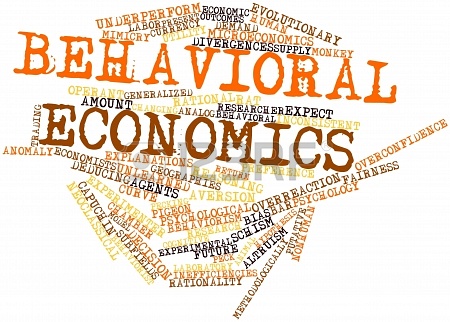The traditional economic theories and models are built upon the assumption of rational behaviour by Homo economicus or the economic man. This economic man makes rational and logical decision, by carefully carrying out a cost-benefit analysis of the available options and arriving at a decision that optimizes his gains (both monetary/material as well as utility/satisfaction). The economic man is very calculative and strong-willed; doing what needs to be done without any delay in order to achieve his long-term goals. But here’s the catch: he doesn’t exists. What exists in his place is Homo sapiens, who can be irrational and poor-decision maker. This irrational man is the ideal agent for the developing sub-discipline of economics which is known as Behavioural economics.
Behavioural economics can be defined as a sub-field of economics which “uses variants of traditional economic assumptions (often with a psychological motivation) to explain and predict behaviour, and to provide policy prescriptions.”
Back in the days, when economics had just been recognized as a separate field of study, no one had even thought of a separate field of psychology. Instead, economists took it upon themselves to contribute certain novel ideas which are very relevant even today. We’ve all heard of Adam Smith’s most recognized work: The Wealth of Nations, but did you know that he had written another (less popular) book known as The Theory Of Moral Sentiments? This book talks about psychological principles of human behaviour which lays down some of the founding principles of behavioural economics. For instance Adam Smith talks about loss aversion when he commented, “we suffer more… when we fall from a better to a worse situation, than we ever enjoy when we rise from a worse to a better.”
The proper integration of the two fields, however, began in 1960s with the rise in the popularity of cognitive school of psychology which equated the brain to “an information processing centre”. This definition made it possible for researchers to further study brain’s various cognitive processes like memory, decision-making and problem solving. This attracted a wide number of psychologists such as Ward Edwards, Amos Tversky and Daniel Kahneman among many others. They developed their own psychological models and used the conventional economic model to compare it to their own models. The duo, Tversky and Kahneman, went on to write one of the most widely read paper known as “The Prospect Theory” which showed how sometimes the conventional utility model is violated under certain circumstances and provides psychological reasons for the same.
Behavioural economics doesn’t deny the neo-classical economic models, rather it tries to point out the flaws which have been assumed inappropriately because of the assumption of rationality. This doesn’t mean that the assumption is wrong; rather it points out that humans have bounded rationality. The concept of bounded rationality states that human rationality is limited by certain factors, namely- time, available information and our thinking capacity. This means that we are bound to make errors in decision making because of the above constraints. Also, our brains have been wired to resort to heuristics (simple thinking strategies). Because of this we are left susceptible to a number of biases such as availability heuristics. People predict future events on the basis of information which is readily available. It is for this reason that casinos celebrate your winning by ringing loud bells and all while your losses are met with silence. By doing so, they make the memory of your win as vivid as possible in an attempt to lure you again to place bets. Other such biases include hindsight bias, gambler’s fallacy, curse of knowledge, belief perseverance, and overconfidence among many others. It is important to understand that just as every cloud has a silver lining, heuristics makes our life easier.
Let’s take a look into some of the biases in depth-
- Anchoring effect– Humans have a tendency to set certain reference points (or anchors) which then influences their decision making by making the anchor, the point of comparison. Consider this: you are have been selected for a job and are in discussion regarding your pay. The first package offered to you becomes your anchor. You may either negotiate (but your final pay would be around the anchor) or you may walk out. Even if you choose the latter option, it would still act as a reference point for the next interview
- Endowment effect– Endowment effect is the cognitive bias to overvalue what we have over what we don’t have. It doesn’t matter if the object in question was purchased or received as a gift, the effect still holds. We would be unwilling to sell our possession (say for example a shirt) at a certain price and would instead demand a higher price than what is offered (even though it may be unreasonably high). But we ourselves wouldn’t buy that same commodity for the price that we had asked for. This shows that we are scared of losing out what we already have. It could be used as a strong incentive to either promote desirable behaviour (by taking away something that they own).
- Default Bias– Since our brain tends to get cramped with information when too many options are available, it tends to go with the option that is given to us as a ‘default’. This is another of our common bias which can be widely observed in any restraint. When confused about what to order, we tend to just go with whatever is suggested by the waiter. This way our brain is saved the trouble of going through 100s of options listed out in the menu. One of the most well-known applications of default bias is in the area of enrolment into retirement savings schemes and pensions. In this case, employees are automatically opted into a scheme by their employer (although they have complete freedom to opt-out if they so choose). Research conducted in the US found that auto-enrolling employees into a retirement savings scheme raised enrolment from 49% to 86% which further increased to 90%.
- Sunk cost effect– It is, yet, another one of human cognitive bias in which one continues to invest in a project even though the project may not be yielding expected profits or may even run losses. This is because invested interests make it hard for us to accept the fact that we or the project might have failed. As a result, we continue to invest (time, energy and money) in a project which only leads to wastage of our resources. This tendency, which is known as the sunk cost effect, can be illustrated by the adage “throwing good money after bad.” This is what makes shutting down of a loss-making business hard for the owners.
- Planning fallacy– The term is pretty much self- explanatory; we underestimate the time and amount of effort required to be inputted in a project. Being students, you know what I mean. (It is totally relatable). But why does this happen? To be succinct- overconfidence. Most of us overrate our own capacities and exaggerate our abilities to shape the future. We tend to underestimate the time, costs, and risks of future actions and at the same time overestimate the benefits thereof. On of the famous example of this bias is that the planners of Sydney Opera House estimated that it would be completed by 1963 at a cost of $7million. However it was finally completed in 1973 at a cost of $102million.
Thus we can see that behavioural economics has a wide range of applicability in today’s world; from marketing activities to investing activities. The growing importance of behavioural economics can be seen in the fact that UK’s government has set up ‘Behavioral Insight Team’ to enable the government to formulate better policies.
By Arushi Sharma
Image source:AMP


